Mixed Convection inside a Duct with an Open Trapezoidal Cavity Equipped with Two Discrete Heat Sources and Moving Walls
Abstract
:1. Introduction
2. Geometry Description and the Governing Equations
- Case 0: all the cavity sidewalls are assumed motionless.
- Case 1: the left sidewall moves downward.
- Case 2: the left sidewall moves downward and the right one moves upward.
- Case 3: the right sidewall moves upward.
3. Validation and Grid Independency Analysis
4. Results and Discussion
5. Effects of Various Cases of the Lid-Driven Sidewalls
6. Effects of the Richardson Number
7. Effects of the Reynolds Number Ratio
8. Average Nusselt Number Results
9. Conclusions
- -
- For Case 0, the mixing between the flow and thermal fields inside the duct and the enclosure is not good enough, and they seem to be separated from each other.
- -
- For Cases 1 and 3, the flow field pattern becomes multi-cellular, and an isothermal region near the lid-driven sidewall of the cavity is noticed.
- -
- For Case 2, the combination between the flow and thermal fields inside the duct and the cavity is efficient due to the movement of both sidewalls of the cavity.
- -
- The Reynolds number ratio and the movement of the cavity sidewall(s) generated a significant impact on the velocity and temperature contours inside the cavity itself.
- -
- The effect of the lid-driven sidewall(s) of the cavity and the forced convection became dominant for low values of Richardson number. Additionally, the free convection impact was critical for high Richardson values.
- -
- The Nuavg increases as the Richardson number and Re number ratio increase.
- -
- The Nuavg was enhanced for moving cavity sidewall(s) compared with stationary walls.
- -
- The maximum values of the Nuavg can be found for Case 1 and heater 2.
- -
- Heater 1 is preferable and recommended when both sidewalls of the cavity are considered to be moving, while heater 2 is better when one sidewall is moved.
Author Contributions
Funding
Conflicts of Interest
Nomenclature
| D | Height or diameter of the duct (m) |
| g | Gravitational acceleration (m/s2) |
| Gr | Grashof number |
| h | Convection heat transfer coefficient (W/m2·C) |
| H | Height and width of the cavity (m) |
| L | Exit length (m) |
| LH | Length of the localized heat source (m) |
| n | Normal vector |
| Nu | Nusselt number |
| P | Dimensionless pressure |
| p | Pressure (N/m2) |
| Pr | Prandtl number |
| Q | Heat flux (W/m2) |
| Re | Reynolds number |
| Rer | Reynolds number ratio |
| Ri | Richardson number |
| T | Temperature (°C) |
| U | Dimensionless velocity component in X-direction |
| u | Velocity component in x-direction (m/s) |
| V | Dimensionless velocity component in Y-direction |
| v | Velocity component in y-direction (m/s) |
| X | Dimensionless coordinate in the horizontal direction |
| x | Cartesian coordinate in the horizontal direction (m) |
| Y | Dimensionless coordinate in the vertical direction |
| y | Cartesian coordinate in the vertical direction (m) |
| Greek symbols | |
| θ | Dimensionless temperature |
| Thermal expansion coefficient (1/K) | |
| ε | Dimensionless length of the localized heat source |
| Thermal diffusivity (m2/s) | |
| Dynamic viscosity (kg/m∙s) | |
| Kinematic viscosity (m2/s) | |
| Density (kg/m3) | |
| Subscripts | |
| avg | Average |
| c | Cold |
| h | Hot |
| in | Inlet |
| Lid | Lid-driven |
References
- Ismael, M.A.; Hussein, A.K.; Mebarek-Oudina, F.; Kolsi, L. Effect of Driven Sidewalls on Mixed Convection in Open Trapezoidal Cavity with Channel. J. Heat Transf. 2020, 142, 082601. [Google Scholar] [CrossRef]
- Mebarek-Oudina, F.; Bessaïh, R. Numerical Simulation of Natural Convection Heat Transfer of Copper-Water Nanofluid in a Vertical Cylindrical Annulus with Heat Sources. Thermophys. Aeromechanics 2019, 26, 325–334. [Google Scholar] [CrossRef]
- Mebarek-Oudina, F.; Laouira, H.; Aissa, A.; Hussein, A.K.; El Ganaoui, M. Convection Heat Transfer Analysis in a Channel with an Open Trapezoidal Cavity: Heat Source Locations effect. MATEC Web Conf. 2020, 330, 01006. [Google Scholar] [CrossRef]
- Mebarek-Oudina, F. Convective Heat Transfer of Titania Nanofluids of different base fluids in Cylindrical Annulus with discrete Heat Source. Heat Transf. Asian Res. 2019, 48, 135–147. [Google Scholar] [CrossRef] [Green Version]
- Chabani, I.; MebarekOudina, F.; Ismail, A.I. MHD Flow of a Hybrid Nano-fluid in a Triangular Enclosure with Zigzags and an Elliptic Obstacle. Micromachines 2022, 13, 224. [Google Scholar] [CrossRef]
- Gourari, S.; Mebarek-Oudina, F.; Hussein, A.K.; Kolsi, L.; Hassen, W.; Younis, O. Numerical study of natural convection between two coaxial inclined cylinders. Int. J. Heat Technol. 2019, 37, 779–786. [Google Scholar] [CrossRef]
- Esfe, M.; Saedodin, S.; Malekshah, E.; Babaie, A.; Rostamian, H. Mixed convection inside lid-driven cavities filled with nanofluids: A comprehensive review. J. Therm. Anal. Calorim. 2019, 135, 813–859. [Google Scholar] [CrossRef]
- Izadi, S.; Armaghani, T.; Ghasemiasl, R.; Chamkha, A.; Molana, M. A comprehensive review on mixed convection of nanofluids in various shapes of enclosures. Powder Technol. 2019, 343, 880–907. [Google Scholar] [CrossRef]
- Manca, O.; Nardini, S.; Khanafer, K.; Vafai, K. Effect of heated wall position on mixed convection in a channel with an open cavity. Numer. Heat Transf. Part A 2003, 43, 259–282. [Google Scholar] [CrossRef]
- Brown, N.; Lai, F. Correlations for combined heat and mass transfer from an open cavity in a horizontal channel. Int. Commun. Heat Mass Transf. 2005, 32, 1000–1008. [Google Scholar] [CrossRef]
- Leong, J.; Brown, N.; Lai, F. Mixed convection from an open cavity in a horizontal channel. Int. Commun. Heat Mass Transf. 2005, 32, 583–592. [Google Scholar] [CrossRef]
- Stiriba, Y. Analysis of the flow and heat transfer characteristics for assisting incompressible laminar flow past an open cavity. Int. Commun. Heat Mass Transf. 2008, 35, 901–907. [Google Scholar] [CrossRef]
- Stiriba, Y.; Grau, F.; Ferre, J.; Vernet, A. A numerical study of three-dimensional laminar mixed convection past an open cavity. Int. J. Heat Mass Transf. 2010, 53, 4797–4808. [Google Scholar] [CrossRef]
- Wong, K.; Saeid, N. Numerical study of mixed convection on jet impingement cooling in an open cavity filled with porous medium. Int. Commun. Heat Mass Transf. 2009, 36, 155–160. [Google Scholar] [CrossRef]
- Rahman, M.; Parvin, S.; Saidur, R.; Rahim, N. Magnetohydrodynamic mixed convection in a horizontal channel with an open cavity. Int. Commun. Heat Mass Transf. 2011, 38, 184–193. [Google Scholar] [CrossRef]
- Rahman, M.; Oztop, H.; Rahim, N.; Saidur, R.; Al-Salem, K.; Amin, N.; Mamun, M.; Ahsan, A. Computational analysis of mixed convection in a channel with a cavity heated from different sides. Int. Commun. Heat Mass Transf. 2012, 39, 78–84. [Google Scholar] [CrossRef]
- Rahman, M.; Oztop, H.; Saidur, R.; Mekhilef, S.; Al-Salem, K. Finite element solution of MHD mixed convection in a channel with a fully or partially heated cavity. Comput. Fluids 2013, 79, 53–64. [Google Scholar] [CrossRef]
- Rahman, M.; Parvin, S.; Rahim, N.; Hasanuzzaman, M.; Saidur, R. Simulation of mixed convection heat transfer in a horizontal channel with an open cavity containing a heated hollow cylinder. Heat Transf. Asian Res. 2012, 41, 339–353. [Google Scholar] [CrossRef]
- Stiriba, Y.; Ferre, J.; Grau, F. Heat transfer and fluid flow characteristics of laminar flow past an open cavity with heating from below. Int. Commun. Heat Mass Transf. 2013, 43, 8–15. [Google Scholar] [CrossRef]
- Abdelmassih, G.; Vernet, A.; Pallares, J. Numerical simulation of incompressible laminar flow in a three-dimensional channel with a cubical open cavity with a bottom wall heated. J. Physics. Conf. Ser. 2012, 395, 1–7. [Google Scholar] [CrossRef]
- Azad, A.; Munshi, M.; Rahman, M.; Chowdhury, M. Analysis of combined convection in an open cavity under constant heat flux boundary conditions and magnetic field using finite element method. J. Sci. Res. 2014, 6, 243–256. [Google Scholar]
- Burgos, J.; Cuesta, I.; Saluena, C. Numerical study of laminar mixed convection in a square open cavity. Int. J. Heat Mass Transf. 2016, 99, 599–612. [Google Scholar] [CrossRef]
- Zamzari, F.; Mehrez, Z.; El-Cafsi, A.; Belghith, A.; le Quéré, P. Numerical investigation of entropy generation and heat transfer of pulsating flow in a horizontal channel with an open cavity. J. Hydrodyn. 2017, 29, 632–646. [Google Scholar] [CrossRef]
- Sabbar, W.; Ismael, M.; Al-Mudhaffar, M. Fluid-structure interaction of mixed convection in a cavity-channel assembly of flexible wall. Int. J. Mech. Sci. 2018, 149, 73–83. [Google Scholar] [CrossRef]
- Sivasankaran, S.; Al-Zaharani, F.; Al-Shomrani, A. Effect of baffle size and thermal boundary conditions on mixed convection flow in a channel with cavity. J. Phys. Conf. Ser. 2018, 1139, 1–8. [Google Scholar] [CrossRef]
- Yasin, N.; Jehhef, K.; Shaker, A. Assessment of the baffle effects on the mixed convection in open cavity. Int. J. Mech. Mechatron. Eng. 2018, 18, 1–14. [Google Scholar]
- Contreras, H.; Trevino, C.; Lizardi, J.; Martinez-Suastegui, L. Stereoscopic TR-PIV measurements of mixed convection flow in a vertical channel with an open cavity with discrete heating. Int. J. Mech. Sci. 2019, 150, 427–444. [Google Scholar] [CrossRef]
- Cardenas, V.; Trevino, C.; Rosas, I.; Martinez-Suastegui, L. Experimental study of buoyancy and inclination effects on transient mixed convection heat transfer in a channel with two symmetric open cubic cavities with prescribed heat flux. Int. J. Therm. Sci. 2019, 140, 71–86. [Google Scholar] [CrossRef]
- Laouira, H.; Mebarek-Oudina, F.; Hussein, A.K.; Kolsi, L.; Merah, A.; Younis, O. Heat transfer inside a horizontal channel with an open trapezoidal enclosure subjected to a heat source of different lengths. Heat Transf. Asian Res. 2020, 49, 406–423. [Google Scholar] [CrossRef]
- Fusegi, T. Numerical study of convective heat transfer from periodic open cavities in a channel with oscillatory through flow. Int. J. Heat Fluid Flow 1997, 18, 376–383. [Google Scholar] [CrossRef]
- Manca, O.; Nardini, S.; Naso, V.; Pitzolu, R. Mixed convection in a channel with an open cavity below, Paper ID-142. In Proceedings of the 7th Fluid Control, Measurements and Visualization-FLUCOME, Sorrento, Italy, 25–28 August 2003. [Google Scholar]
- Manca, O.; Nardini, S.; Vafai, K. Experimental investigation of mixed convection in a channel with an open cavity. Exp. Heat Transf. 2006, 19, 53–62. [Google Scholar] [CrossRef]
- Manca, O.; Nardini, S.; Vafai, K. Experimental investigation of opposing mixed convection in a channel with an open cavity below. Exp. Heat Transf. 2008, 21, 99–114. [Google Scholar] [CrossRef]
- Marzougui, S.; Mebarek-Oudina, F.; Mchirgui, A.; Magherbi, M. Entropy Generation and Heat transport of Cu-water Nanoliquid in Porous lid-driven Cavity through Magnetic Field. Int. J. Numer. Methods Heat Fluid Flow, 2021; in press. [Google Scholar] [CrossRef]
- Buonomo, B.; Foglia, G.; Manca, O.; Nardini, S. Numerical study on mixed convection in a channel with an open cavity filled with porous media. In Proceedings of the 5th European Thermal—Sciences Conference, Eindhoven, The Netherlands, 18–22 May 2008; pp. 1–8. [Google Scholar]
- Aminossadati, S.; Ghasemi, B. A numerical study of mixed convection in a horizontal channel with a discrete heat source in an open cavity. Eur. J. Mech. B/Fluids 2009, 28, 590–598. [Google Scholar] [CrossRef]
- Rahman, M.; Saidur, R.; Rahim, N. Conjugated effect of joule heating and magneto-hydrodynamic on double-diffusive mixed convection in a horizontal channel with an open cavity. Int. J. Heat Mass Transf. 2011, 54, 3201–3213. [Google Scholar] [CrossRef]
- Rahman, M.; Oztop, H.; Ahsan, A.; Kalam, M.; Billah, M. MHD mixed convection in a channel with a triangular cavity. Numer. Heat Transf. Part A 2012, 61, 268–282. [Google Scholar] [CrossRef]
- Buonomo, B.; Cresci, G.; Manca, O.; Mesolella, P.; Nardini, S. Transient mixed convection in a channel with an open cavity filled with porous media. J. Phys. Conf. Ser. 2012, 395, 1–8. [Google Scholar] [CrossRef]
- Selimefendigil, F. Numerical analysis and POD based interpolation of mixed convection heat transfer in horizontal channel with cavity heated from below. Eng. Appl. Comput. Fluid Mech. 2013, 7, 261–271. [Google Scholar] [CrossRef] [Green Version]
- Zamzari, F.; Mehrez, Z.; El-Cafsi, A.; Belghith, A. Entropy generation and mixed convection in a horizontal channel with an open cavity. Int. J. Exergy 2015, 17, 219–239. [Google Scholar] [CrossRef]
- Abdelmassih, G.; Vernet, A.; Pallares, J. Steady and unsteady mixed convection flow in a cubical open cavity with the bottom wall heated. Int. J. Heat Mass Transf. 2016, 101, 682–691. [Google Scholar] [CrossRef]
- Garcia, F.; Trevino, C.; Lizardi, J.; Martinez-Suastegui, L. Numerical study of buoyancy and inclination effects on transient mixed convection in a channel with two facing cavities with discrete heating. Int. J. Mech. Sci. 2019, 155, 295–314. [Google Scholar] [CrossRef]


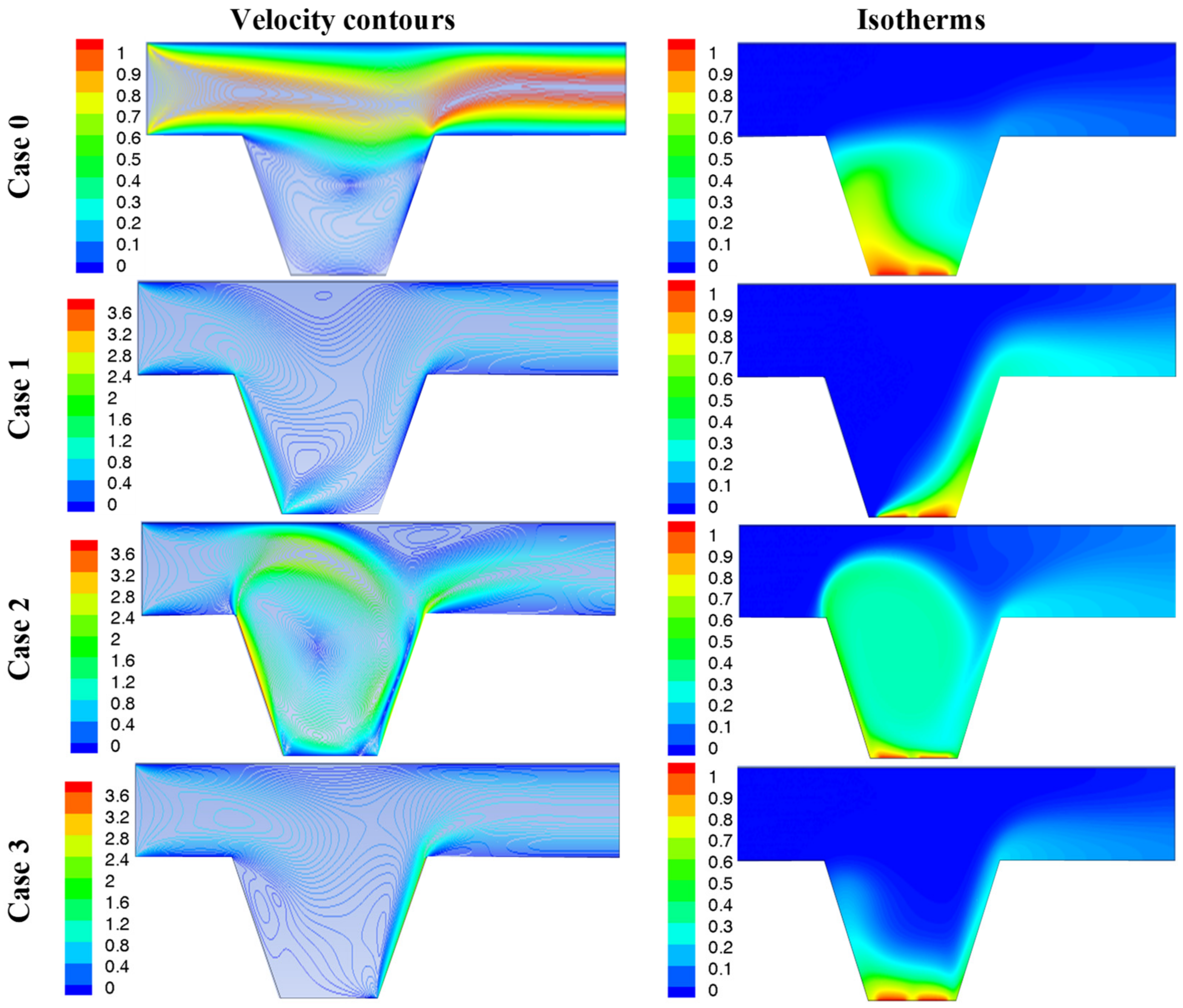
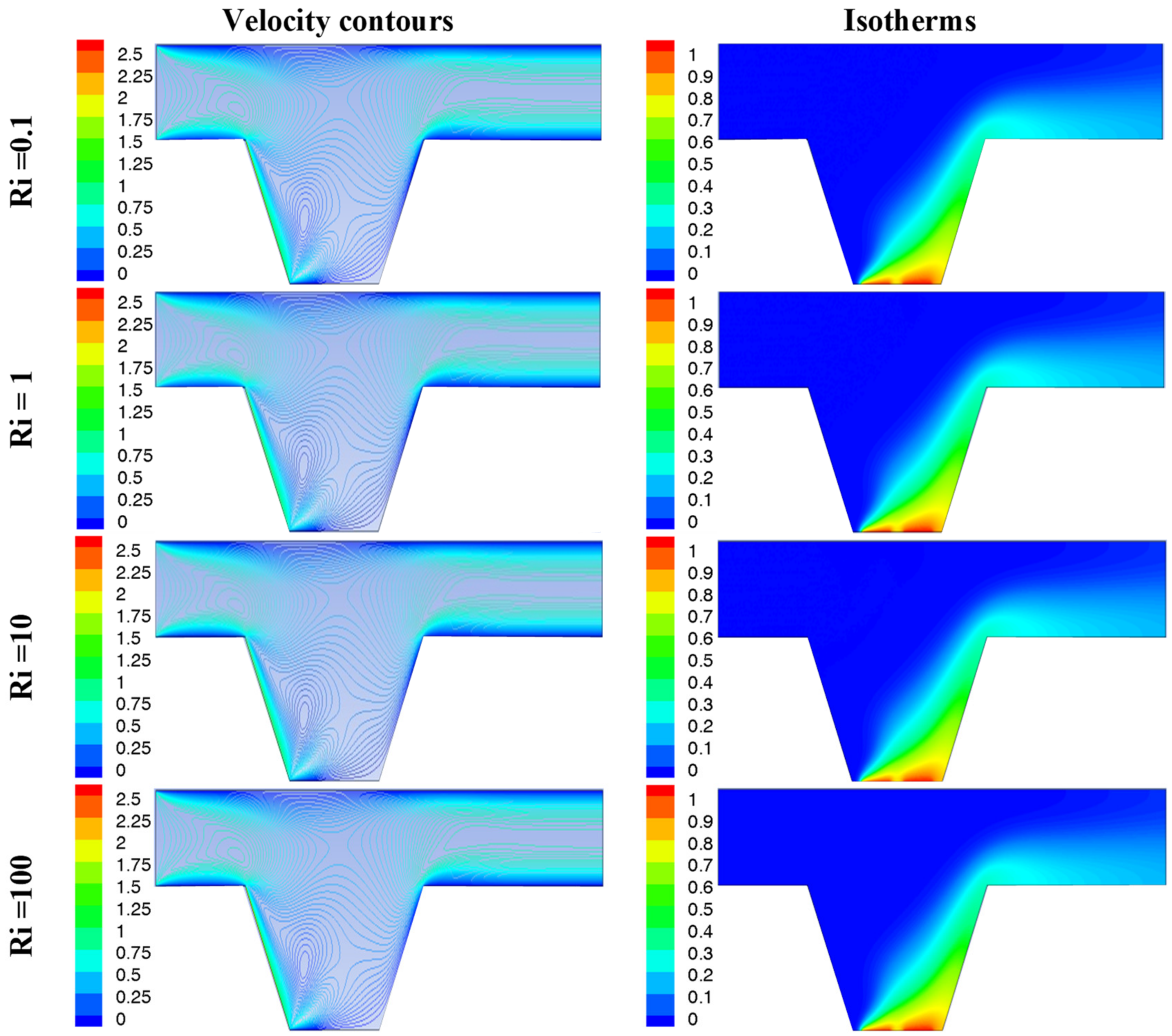

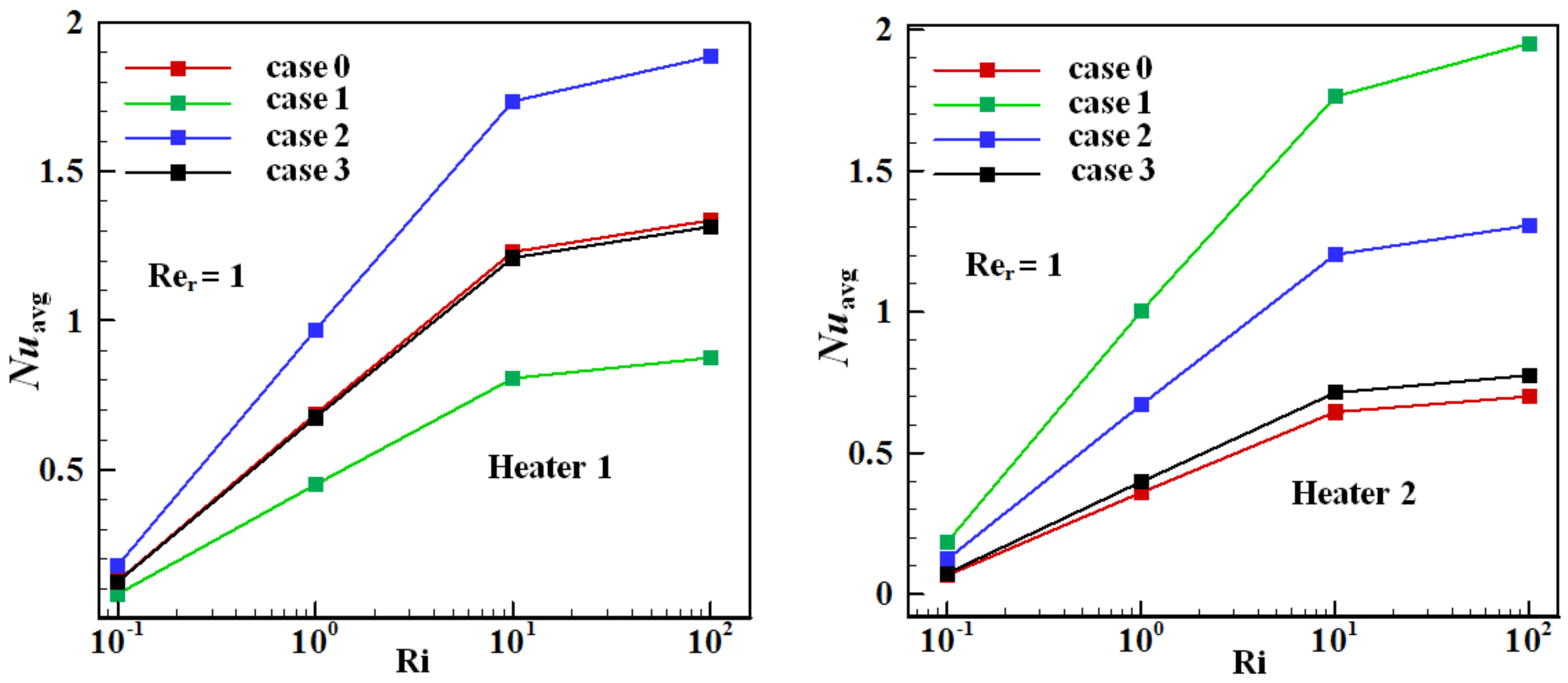
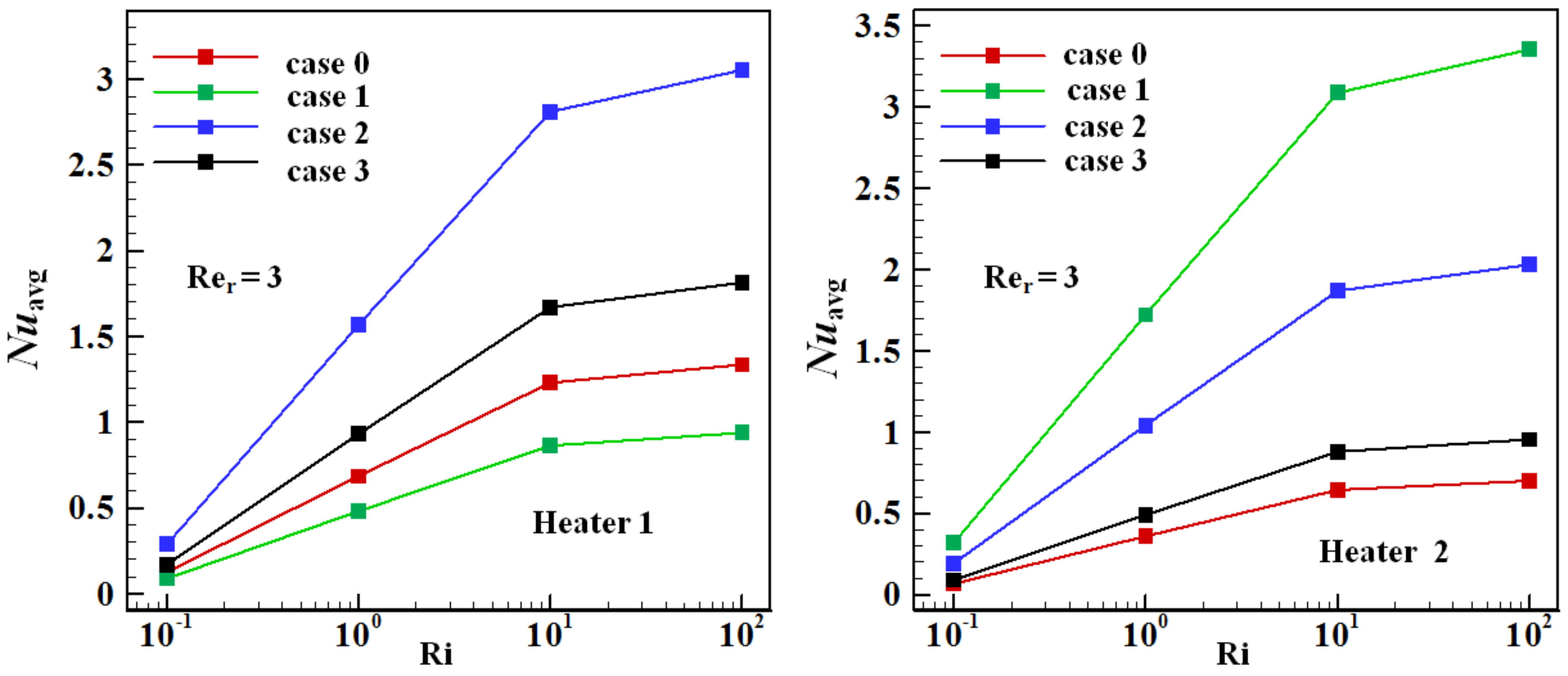
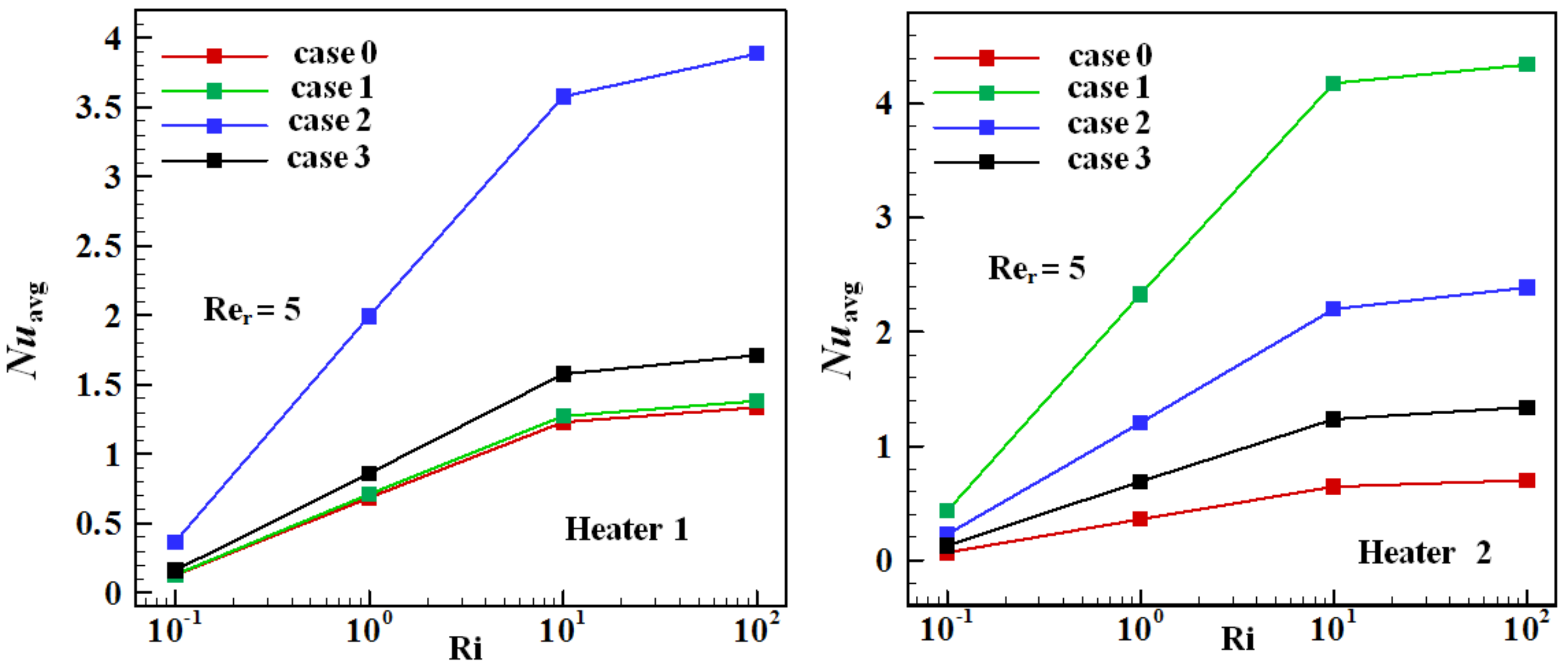
| Nuav | ||
|---|---|---|
| Grid | Heater 1 | Heater 2 |
| G1 (75125) | 0.12583998 | 0.06460179 |
| G2 (60996) | 0.11428922 | 0.0563892 |
| G3 (50554) | 0.12641978 | 0.06621620 |
| G4 (42468) | 0.12497943 | 0.06409777 |
| G5 (36276) | 0.12144383 | 0.060833 |
| G6 (31296) | 0.11671896 | 0.05772451 |
Publisher’s Note: MDPI stays neutral with regard to jurisdictional claims in published maps and institutional affiliations. |
© 2022 by the authors. Licensee MDPI, Basel, Switzerland. This article is an open access article distributed under the terms and conditions of the Creative Commons Attribution (CC BY) license (https://creativecommons.org/licenses/by/4.0/).
Share and Cite
Mebarek-Oudina, F.; Laouira, H.; Hussein, A.K.; Omri, M.; Abderrahmane, A.; Kolsi, L.; Biswal, U. Mixed Convection inside a Duct with an Open Trapezoidal Cavity Equipped with Two Discrete Heat Sources and Moving Walls. Mathematics 2022, 10, 929. https://doi.org/10.3390/math10060929
Mebarek-Oudina F, Laouira H, Hussein AK, Omri M, Abderrahmane A, Kolsi L, Biswal U. Mixed Convection inside a Duct with an Open Trapezoidal Cavity Equipped with Two Discrete Heat Sources and Moving Walls. Mathematics. 2022; 10(6):929. https://doi.org/10.3390/math10060929
Chicago/Turabian StyleMebarek-Oudina, Fateh, Hanane Laouira, Ahmed Kadhim Hussein, Mohamed Omri, Aissa Abderrahmane, Lioua Kolsi, and Uddhaba Biswal. 2022. "Mixed Convection inside a Duct with an Open Trapezoidal Cavity Equipped with Two Discrete Heat Sources and Moving Walls" Mathematics 10, no. 6: 929. https://doi.org/10.3390/math10060929






